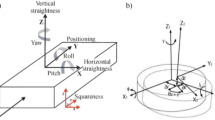Abstract
Recently, there has been an increasing need to produce more precise products, with only the smallest deviations from a defined target value. Machine capability is the ability of a machine tool to produce parts within the tolerance interval. Capability indices are a statistical way of describing how well a product is machined compared to defined target values and tolerances. Currently, there is no standardized way to acquire a machine capability value. This paper describes how machine capability indices are evaluated in machining centers. After the machining of specimens, straightness, roundness and positioning accuracy were measured using CMM(coordinate measuring machine). These measured values and defined tolerances were used to evaluate the machine capability index. It will be useful for the industry to have standardized ways to choose and calculate machine capability indices.
Similar content being viewed by others
References
H. J. Shin and J. J. Lee, 2000, A study on development of process incapability index model including gage R&R, The Korean Institute of Plant Engineering, 5 (2000) 35–48.
S. G. Ko, J. M. Hwang, and Y. S. Kim, Practical guideline of process capability indices, The Korean Society for Quality Management, 2(1) (2001) 23–33.
S. H. Lee, Engineering Statistic Analysis using Minitab, Eretec, Korea (2008).
D. K. Lee, A new multivariate process capability index, Journal Research of Kum-Oh National University of Technology, 20 (1999) 153–160.
N. K. Kwon, A proposed process capability index for nonnormal process, Master’s degree, Kum-Oh National Institute of Technology, Korea (2002).
P. Stadlbauer, Statistic / Destructive-nondestructive Testing, A ThyssenKrupp Technologies Company (2007).
D. M. Lee, Z. Zhu, K. I. Lee, and S. H. Yang, Identification and measurement of geometric errors for a 5-axis machine tool with a tilting head using a Double ball-bar, Int. J. Precision Engineering & Manufacturing, 12(2) (2011) 337–343.
E. C. Jeon, S. Y. Lee, W. H. Lee, D. H. Kim, and J. D. Chun, A study on the improvement of productivity and surface roughness in mold machining using the optimization of cutting force, J. of manufacturing engineering & technology, 20(6) (2011) 824–829.
Eretec Minitab Business Team, New Minitab Working Completion, Eretec, Korea (2005).
A. Larsson, Capability in machining systems, A Licentiate Thesis, Royal Institute of Technology, Sweden (2002).
KS, Test conditions for machining centres — Part 7: Accuracy of a finished test piece, KS B ISO 10791-7, Korea Standard Association (2007).
H. S. Choi, 2006, New Tolerance theory, Sungandang, Korea (2006).
S. S. Kim, A study on measuring and evaluation methods of straightness of machining centers, Journal of the Institute Research of Mechanical Technology, 2(2) (1999) 59–74.
J. G. Kang and S. Y. Rhee, A Study of the Evaluation of Circularity by the Minimum Zone Principle, Center for Advanced Materials of Kyung-Nam University, 3 (1993) 229–238.
S. H. Jo, Application Measurement Practice, Gijeon, Korea (2007).
Dukin, Geometrical Tolerance (GD & T), Dukin Inc., Korea (1999).
Y. K. Hwang, J. H. Park, and P. S. Shim, Development of a variable preload spindle by using magnetic actuator, KSPE 2011 Spring Conference (2011) 805–806.
J. H. Choi, I. H. Kim, S. W. Park, and D. Y. Jang, 1-axis displacement sensor for compensation thermal error of high-speed spindle, KSPE 2010 Spring Conference (2010) 113–114.
Author information
Authors and Affiliations
Corresponding author
Additional information
Recommended by Guest Editor Haedo Jeong
Won-Pyo Hong received B. S. (1993) degree in Precision Engineering and Mechatronics from KAIST, Korea. He received M. S. (1995) and Ph.D. (2001) degrees in Mechanical Engineering from KAIST. Dr. Hong is currently a Principal Researcher at the IT converged process R&D group of KITECH in Ansan, Korea.
Rights and permissions
About this article
Cite this article
Hong, WP. Machine capability index evaluation of machining center. J Mech Sci Technol 27, 2905–2910 (2013). https://doi.org/10.1007/s12206-013-0801-8
Received:
Revised:
Accepted:
Published:
Issue Date:
DOI: https://doi.org/10.1007/s12206-013-0801-8




